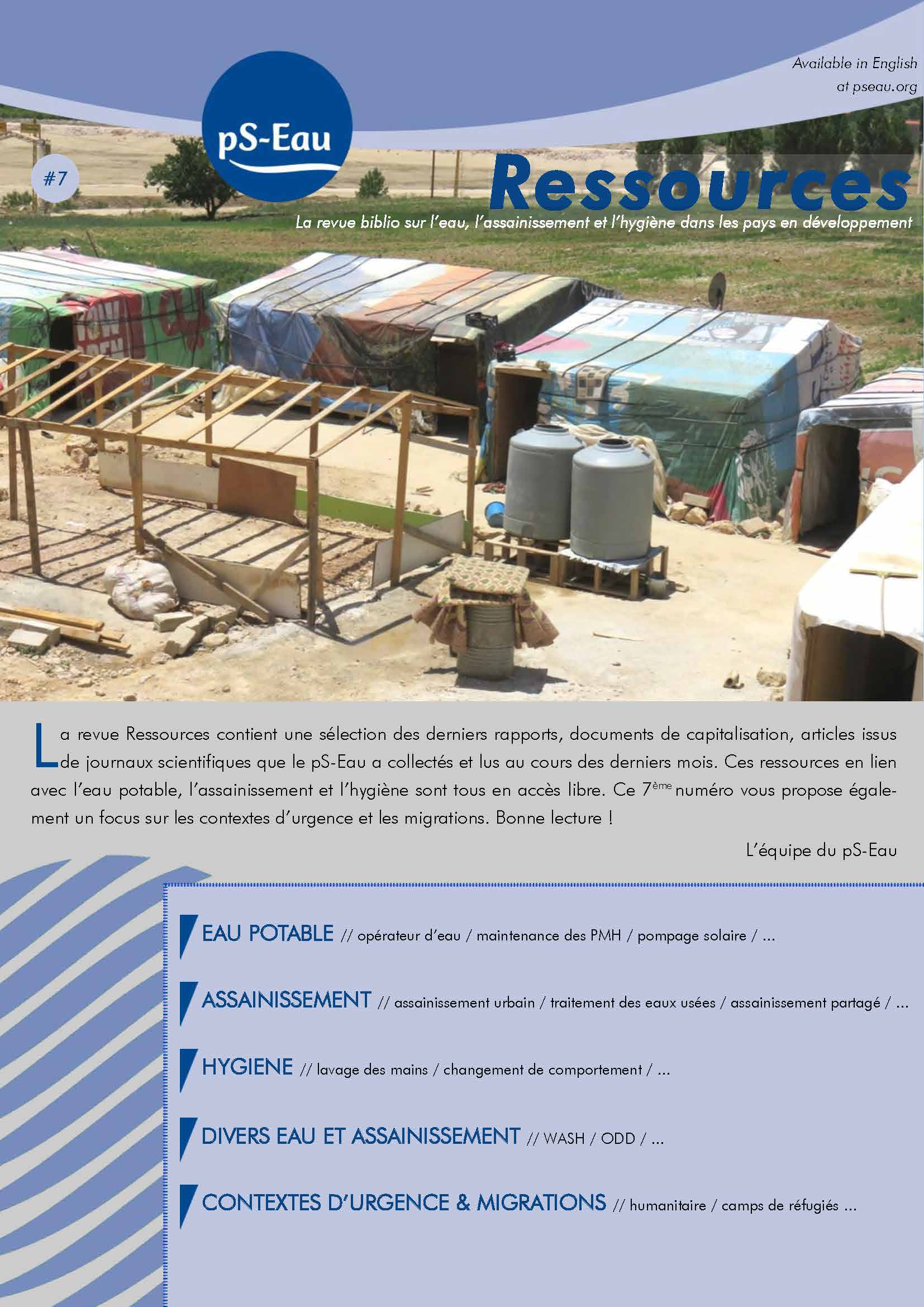
2018 ; 7 pages PdF
Ed. pS-Eau - Paris
Résumé:
La revue Ressources contient une sélection des derniers rapports, documents de capitalisation, articles issus de journaux scientifiques que le pS-Eau a collectés et lus au cours des derniers mois. Ces ressources en lien avec l’eau potable, l’assainissement et l’hygiène sont tous en accès libre. Ce 7ème numéro vous propose égale-ment un focus sur les contextes d’urgence et les migrations. Bonne lecture !
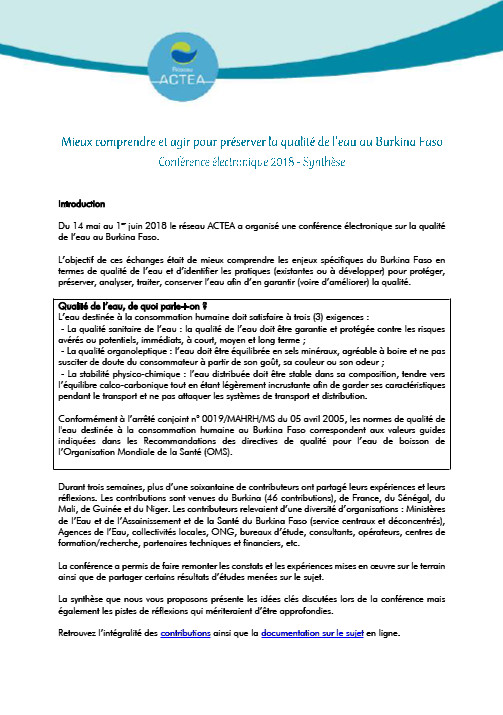
2018 ; 6 pages PdF
Ed. ACDIL - Ouagadougou pS-Eau - Paris ACTEA - Ouagadougou
Résumé:
Synthèse de la conférence électronique organisée par le réseau ACTEA du 14 mai au 1er juin.
Qualité de l’eau, de quoi parle-t-on ?
L’eau destinée à la consommation humaine doit satisfaire à trois (3) exigences :
- La qualité sanitaire de l’eau : la qualité de l’eau doit être garantie et protégée contre les risques avérés ou potentiels, immédiats, à court, moyen et long terme ;
- La qualité organoleptique : l’eau doit être équilibrée en sels minéraux, agréable à boire et ne pas susciter de doute du consommateur à partir de son goût, sa couleur ou son odeur ;
- La stabilité physico-chimique : l’eau distribuée doit être stable dans sa composition, tendre vers l’équilibre calco-carbonique tout en étant légèrement incrustante afin de garder ses caractéristiques pendant le transport et ne pas attaquer les systèmes de transport et distribution.
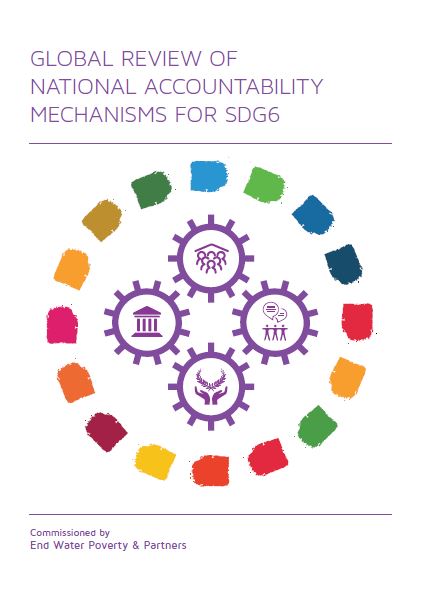
2018 ; 180 pages
Ed. Coalition Eau - Nogent sur Marne End Water Poverty - London WSSCC - Genève Watershed Empowering Citizens Consortium - Amsterdam
Résumé:
End Water Proverty, Watershed, la Coalition Eau et WSSCC ont participé à l’élaboration d’un rapport mondial sur les mécanismes de redevabilité nationaux pour la mise en oeuvre de l’ODD 6 sur l’eau et l’assainissement, publié en juillet 2018 à l’occasion du forum politique de haut niveau (en anglais). Le résumé de cette étude, ainsi que ses messages clés, sont disponibles en français.
Abstract:
This study took place between October 2017 and March 2018 and was led by civil society organisations (CSOs) in 25 countries under the umbrella of End Water Poverty, Watershed Consortium, Coalition Eau and the Water Supply and Sanitation Collaborative Council (WSSCC). Organisations agreed to conduct an in-depth inclusive analysis on country-level accountability mechanisms towards Sustainable Development Goal 6 (SDG 6) on clean water and sanitation implementation and produce a comprehensive report, assessing their strengths, limitations and effectiveness.
The outcomes of this study include enhanced insights on the existing in-country mechanisms and their functioning for SDG 6, resulting in tools for CSOs to find more or better ways to hold their government accountable for reaching SDG6 targets and meaningful reporting on progress. It identifies positive experiences of participating in existing accountability mechanisms, as well as the greatest gaps and challenges currently observed in the functioning of accountability mechanisms, from the perspective of governments, civil society and other stakeholders.
The process and the results of the study therefore aim to strengthen CSOs' capacities to advocate for improved accountability mechanisms and their involvement in decision-making and follow-up actions.
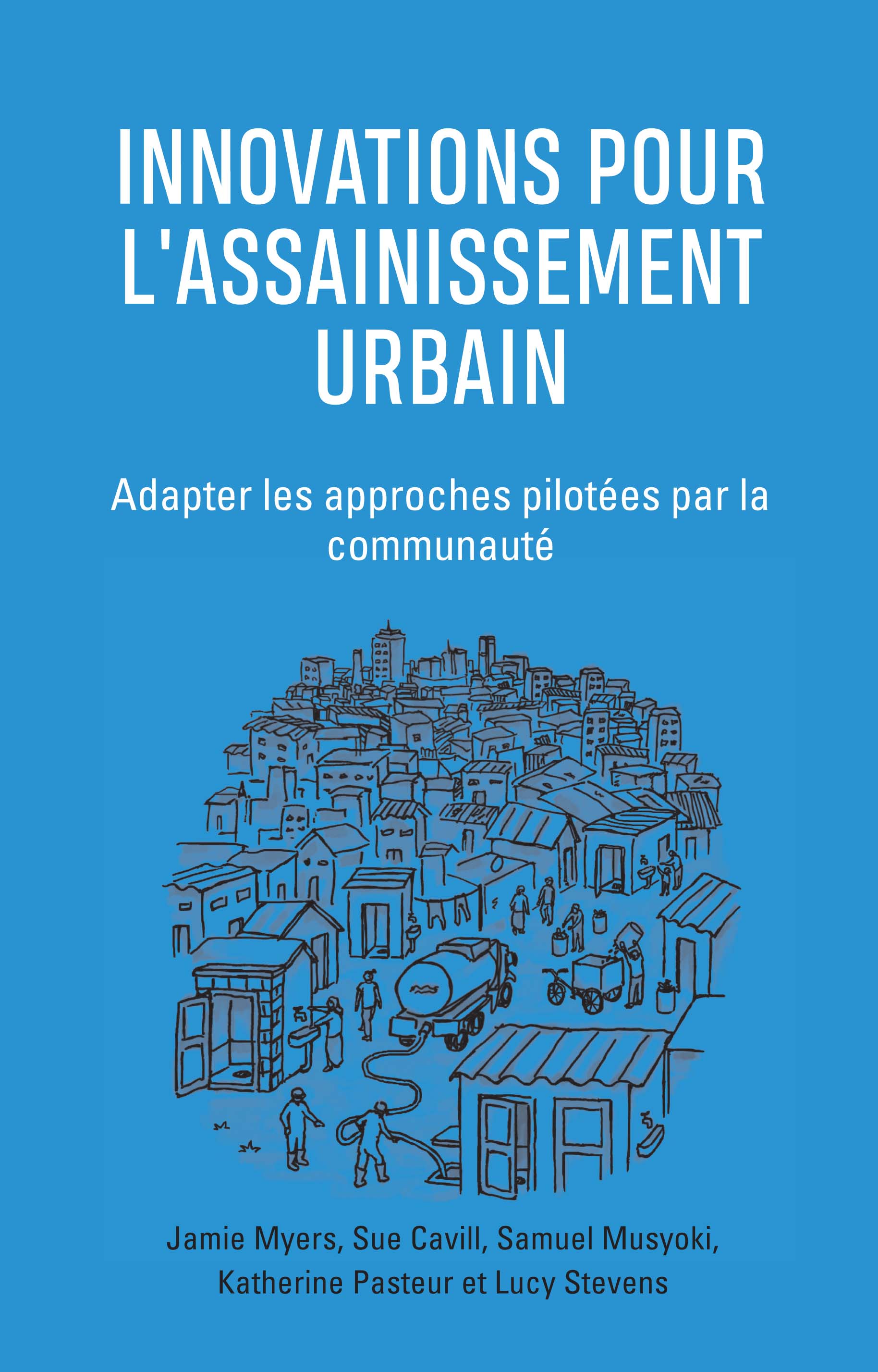
2018 ; 190 pages
Ed. Practical Action - Rugby
Résumé:
Plus de la moitié des occupants de la planète habitent désormais en milieu urbain et une forte proportion d'entre eux vit sans assainissement amélioré. Dans les zones rurales, les efforts déployés pour lutter contre la défécation en plein air ont été dirigés par le mouvement de l'Assainissement total piloté par la communauté (ATPC). Toutefois, comment les techniques de mobilisation de la communauté prônées par l'ATPC peuvent-elles être adaptées aux situations plus complexes des zones urbaines ?
Innovations pour l'assainissement urbain a été rédigé en réponse aux demandes de conseils concrets émanant des praticiens sur la manière de mobiliser les communautés pour les inciter à améliorer différents maillons de la chaîne d'assainissement dans les zones urbaines. Il propose un ensemble d'approches, d'outils et de tactiques pour aider les communautés urbaines à progresser vers des services d'assainissement gérés de manière sûre. L'ouvrage donne des exemples de villes et métropoles d'Afrique, d'Asie du Sud et d'Asie du Sud-Est où cette panoplie a été employée.
En tant que stratégie de développement favorable aux pauvres, l'ATPC-U est capable de mobiliser les communautés urbaines pour qu'elles prennent des mesures individuelles et collectives et travaillent avec d'autres parties prenantes pour fournir des services d'eau, d'hygiène et d'assainissement gérés de manière sûre qui ne laissent personne de côté.
Abstract:
Innovations for Urban Sanitation has been developed in response to calls from practitioners for practical guidance on how to mobilize communities and improve different parts of the sanitation chain in urban areas. Urban Community-Led Total Sanitation is potentially an important piece of a bigger puzzle. It offers a set of approaches, tools and tactics for practitioners to move towards safely managed sanitation services. The book provides examples of towns and cities in Africa, South Asia and South-East Asia which have used these approaches.
The approach has the potential to contribute not only to Sustainable Development Goal (SDG) 6 on water, sanitation and hygiene and SDG 11 on cities but also those concerning the reduction of inequalities and the promotion of inclusive societies. As a pro-poor development strategy, U-CLTS can mobilize the urban poor to take their own collective action and demand a response from others to provide safely managed sanitation, hygiene and water services which leave no one behind.
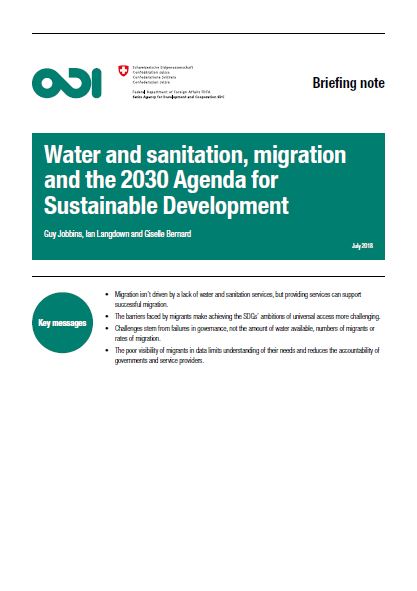
2018 ; 16 pages
Ed. ODI - London
Abstract:
This briefing considers the impact of migration on a variety of WASH-related Sustainable Development Goals (SDGs), chiefly SDG 6: 'to ensure availability and sustainable management of water and sanitation for all'. While water and sanitation do not appear to drive migration, the process of migration can radically shape access to water and sanitation services – particularly for undocumented migrants and people in transit. We question whether attaining 'universal access' is possible without specific measures to address the needs of refugees and other migrants.
Key messages
- Migration isn’t driven by a lack of water and sanitation services, but providing services can support successful migration.
- The barriers faced by migrants make achieving the SDGs' ambitions of universal access more challenging.
- Challenges stem from failures in governance, not the amount of water available, numbers of migrants or rates of migration.
- The poor visibility of migrants in data limits understanding of their needs and reduces the accountability of governments and service providers.
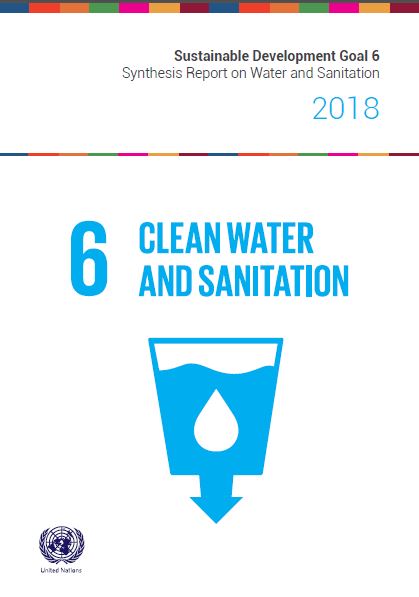
2018 ; 199 pages
Ed. ONU-Eau - Genève
Abstract:
The Sustainable Development Goal 6 Synthesis Report 2018 on Water and Sanitation reviews the global progress made towards achieving Sustainable Development Goal 6 (SDG 6) of the 2030 Agenda for Sustainable Development. It builds on the latest data available for the 11 SDG 6 global indicators and will inform the High-level Political Forum for Sustainable Development during its in-depth review of SDG 6 in July 2018. The report represents a joint position from the United Nations family.
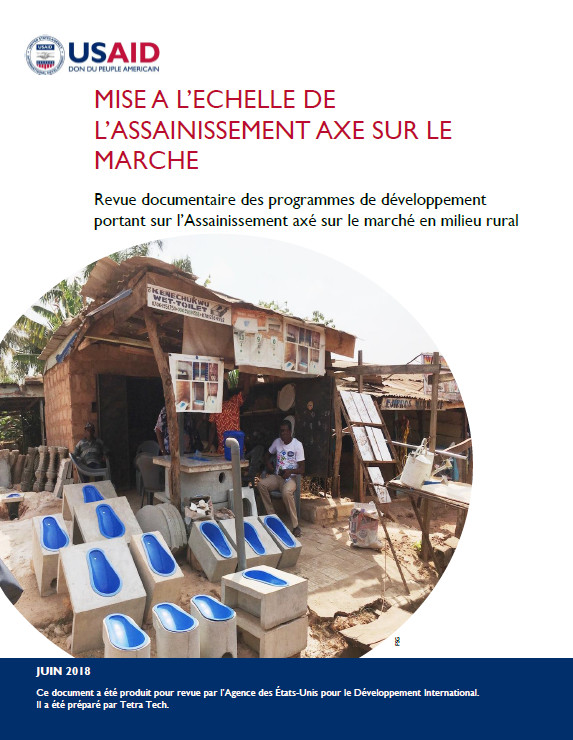
2018 ; 144 pages
Ed. USAID - Washington
Résumé:
Cette revue documentaire décrit l’état actuel des connaissances sur l’assainissement axé sur le marché (AAM) (en anglais market-based sanitation) et établit un cadre analytique permettant d’analyser, de concevoir et d’améliorer des interventions AAM. Elle repose sur un examen de quelque 600 documents sur l’AAM, sur une analyse approfondie de 13 études de cas décrivant des interventions AAM dans l’hémisphère Sud et sur des entretiens avec des experts du secteur et des personnes ayant travaillé sur des programmes AAM.
Les experts considèrent de plus en plus l’AAM comme une approche prometteuse pour élargir la fourniture d’assainissement sur site aux ménages qui ne sont pas connectés à des systèmes centralisés d’acheminement et de collecte des eaux usées. La réussite d’interventions AAM en Asie du Sud-Est et au Bangladesh témoigne de l’avenir prometteur de cette approche, pourtant ces succès se sont révélés difficiles à reproduire dans d’autres régions, tout particulièrement en Afrique subsaharienne et en Inde, où le besoin est le plus grand. Parmi les difficultés que présente la mise à l’échelle d’approches AAM figurent la sélection de modèles économiques et de produits appropriés, la viabilité des entreprises d’assainissement et les problèmes liés à l’obtention de fonds publics et privés à des fins de financement.
Au vu de ce contexte, cette revue documentaire offre un cadre qui : (1) s’appuie sur les connaissances existantes dans les trois principaux domaines mis en avant et les étoffe ; (2) aide les bailleurs de fonds et les responsables de la mise en oeuvre à concevoir, analyser et améliorer des interventions AAM ; et (3) offre des conseils aux parties prenantes et aux pouvoirs publics qui souhaiteraient avoir recours aux marchés de l’assainissement pour élargir la couverture en installations sanitaires et réduire la défécation à l’air libre. Par ailleurs, cette revue documentaire met en avant les paramètres contextuels plus larges qui déterminent l’applicabilité de l’AAM comme approche au sein d’un marché donné.
CONCLUSIONS PRINCIPALES DE L’ETUDE
Peu de « véritables » interventions AAM ont été mises à l’échelle. Sur les 96 interventions que nous avons passées en revue et qui paraissaient de prime abord relever de l’approche AAM, seulement 19 pour cent ont touché 50.000 ménages ou plus. Même si l’on retient un seuil de 10.000 ménages bénéficiaires – seuil que l’on peut qualifier de faible, compte tenu de l’ampleur du défi – seules 45 pour cent des interventions ont franchi ce cap. Parmi les interventions qui ont touché plus de 10.000 ménages, moins de la moitié étaient véritablement axées sur le marché – c’est-à-dire qu’elles facilitaient l’investissement par les ménages tout en renforçant le secteur privé. La plupart des interventions étaient fortement subventionnées ou dépendaient de la fourniture de matériel à court terme par les pouvoirs publics ou les bailleurs de fonds, approches qui, à terme, ne sont probablement pas durables.
Abstract:
This desk review from the USAID/WASHPaLS project investigates the current state of knowledge in market-based sanitation (MBS) and establishes a framework to analyze, design, and improve MBS interventions. This report is based on a survey of approximately 600 documents on MBS, in-depth research into 13 MBS intervention case studies across the global south, and interviews with sector experts and program personnel.
This review offers a framework that draws upon and contributes to existing evidence across the three crucial challenges to scaling MBS—appropriate product and business model choices, viability of sanitation enterprises, and difficulty of unlocking public and private financing for sanitation. It also helps funders and implementers design, analyze, and improve MBS interventions and offers guidance for stakeholders and governments interested in using sanitation markets to expand sanitation coverage and reduce open defecation. In addition, this review highlights the larger contextual parameters that determine the applicability of MBS within a given market.
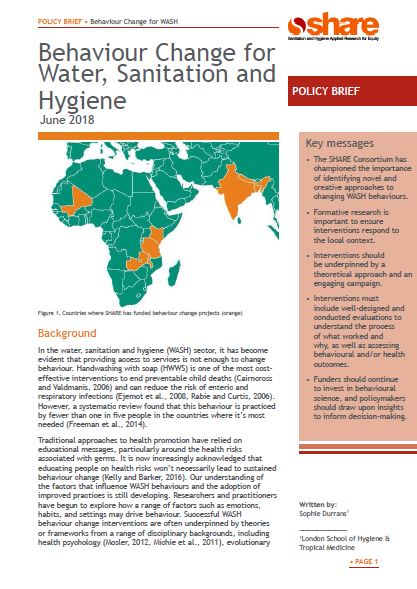
2018 ; 9 pages
Ed. SHARE - London
Abstract:
Since 2010, the SHARE Consortium has prioritised behaviour change in WASH interventions, championing the importance of identifying novel and creative approaches to changing behaviours across many countries. This policy brief documents SHARE’s contribution to understanding behaviour change and associated health impacts. It provides recommendations for researchers and intervention implementers, policy makers and funders.
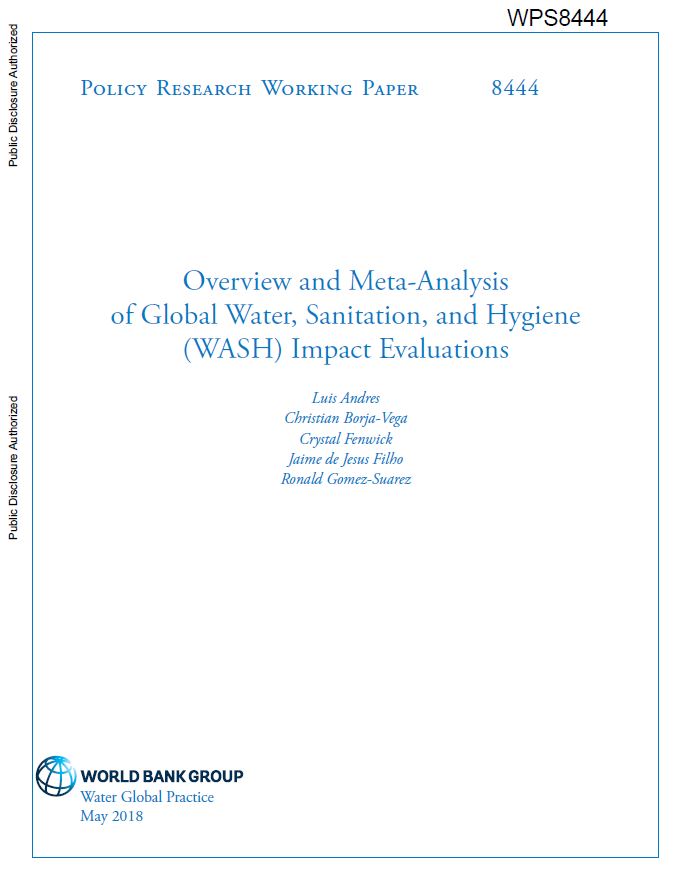
2018 ; 42 pages
Ed. World Bank - Washington
Abstract:
This paper presents an overview and meta-analysis of the effects of water, sanitation, and hygiene interventions around the world. It is based on 136 impact evaluations (randomized and quasi-experimental studies) that explore the effects of water, sanitation, and hygiene interventions on health and non-health outcomes, ranging from behavior change -- such as the adoption of water treatment -- to school attendance rates, to a reduction in diarrhea. The selected impact evaluations were divided into five groups, and meta-regressions with fixed effects (at the regional level) and random effects were performed, controlling for each study's characteristics (implementing organization, sample sizes, type of publication, number of publication views, and so forth). All results are reported as changes in odds ratios, with respect to the standard deviation of reported effects. Water, sanitation, and hygiene interventions were found to increase the likelihood of behavior changes and the adoption of new hygiene practices by 17 percent. The smallest effects were observed from water, sanitation, and hygiene interventions aimed at reducing the rates of child mortality and non-diarrheal disease. Water, sanitation, and hygiene interventions implemented in schools showed statistically significant results in reducing school absenteeism and dropouts. Similarly, the results showed a statistically significant aggregate likelihood of increased access to safe water and improved water quality, as well as increased water treatment options -- a difference of one-fifth with respect to the standard deviation of the average effect size reported. Finally, the results showed that water, sanitation, and hygiene interventions reduced the likelihood of the incidence of diarrheal and enteric disease by 13 percent, which is consistent with findings in other meta-analyses of the same subject
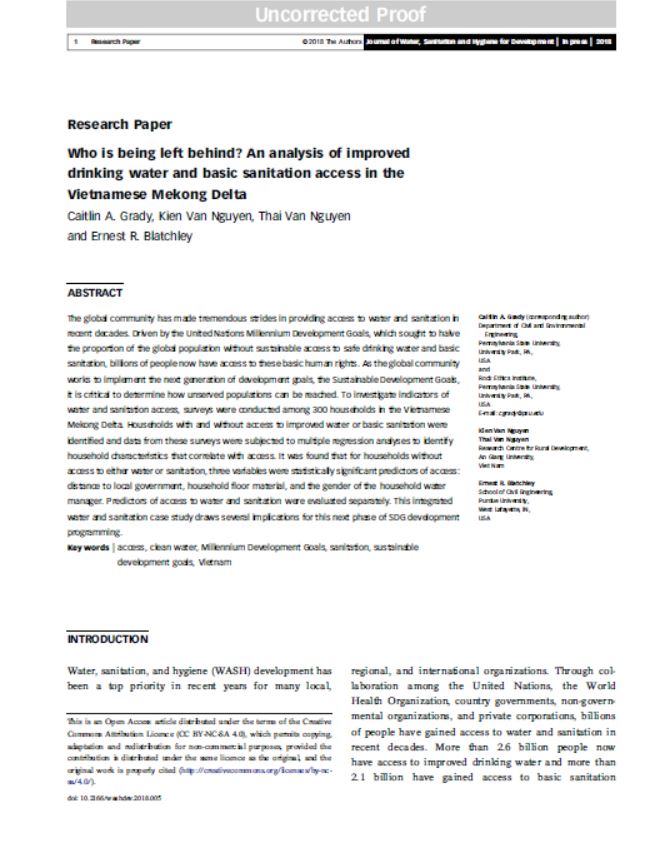
2018 ; 12 pages
Ed. IWA - London
Abstract:
The global community has made tremendous strides in providing access to water and sanitation in recent decades. Driven by the United Nations Millennium Development Goals, which sought to halve the proportion of the global population without sustainable access to safe drinking water and basic sanitation, billions of people now have access to these basic human rights. As the global community works to implement the next generation of development goals, the Sustainable Development Goals, it is critical to determine how unserved populations can be reached. To investigate indicators of water and sanitation access, surveys were conducted among 300 households in the Vietnamese Mekong Delta. Households with and without access to improved water or basic sanitation were identified and data from these surveys were subjected to multiple regression analyses to identify household characteristics that correlate with access. It was found that for households without access to either water or sanitation, three variables were statistically significant predictors of access: distance to local government, household floor material, and the gender of the household water manager. Predictors of access to water and sanitation were evaluated separately. This integrated water and sanitation case study draws several implications for this next phase of SDG development programming.
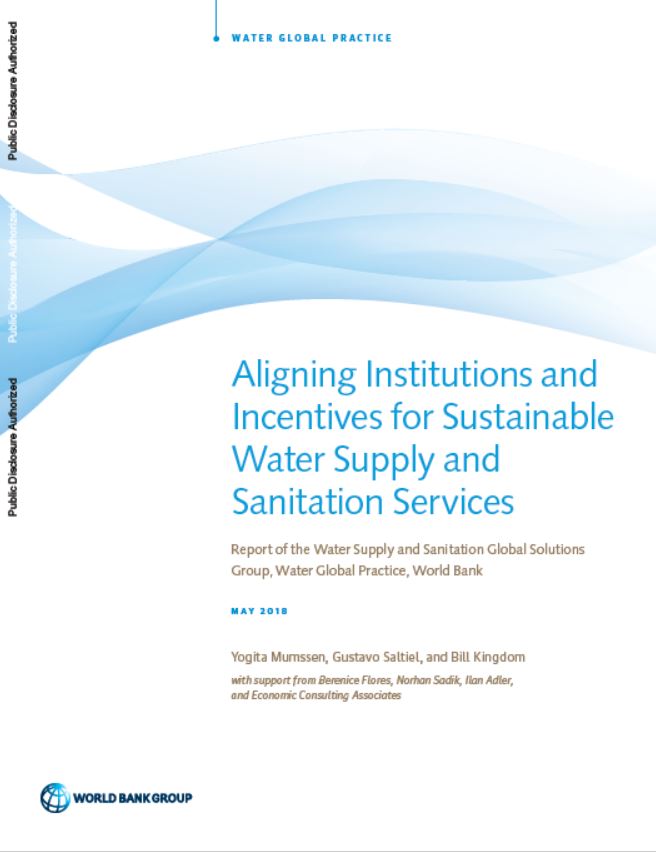
2018 ; 199 pages
Ed. World Bank - Washington
Abstract:
The objective of this study is to analyze how integrated policy, institutional, and regulatory interventions (institutional interventions in brief) can help align incentives for more sustainable water supply and sanitation (WSS) service delivery.
The context for the study is the enhanced global concern about the sustainability of attempts to increase access to, and improve the quality of, WSS services, as exemplified in the sustainable development goals. Aligning institutional interventions refers to harmonization among the objectives for the sector, agreed principles established through political and social processes, and the organizations and mechanisms that implement actions based on such objectives and principles.
This report focuses on the formal policy, institutional, and regulatory interventions available to and or prevalent in the water sector, recognizing the critical importance of the informal conventions that will be key factors in the success of any incentive regime.
Previous global initiatives offered a range of promising technical solutions that often proved to be unsustainable. New thinking that draws not only infrastructure economics but also on the understanding of political, behavioral, and institutional economics is needed. This new thinking must be grounded within the differing contextual realities of countries globally and in lessons learned from what has or has not worked with regards to achieving specific objectives.
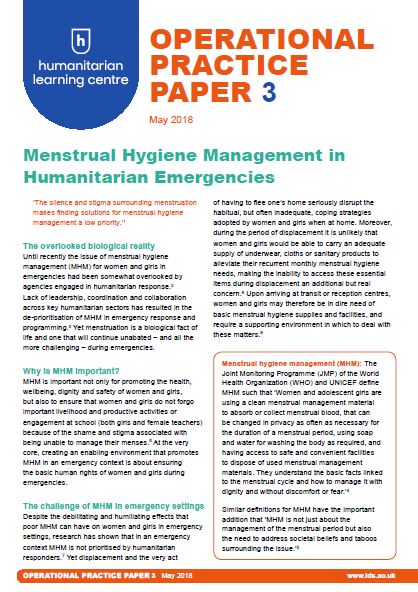
2018 ; 8 pages
Ed. IDS - Brighton
Abstract:
Until recently the issue of menstrual hygiene management (MHM) for women and girls in emergencies had been somewhat overlooked by agencies engaged in humanitarian response. Lack of leadership, coordination and collaboration across key humanitarian sectors has resulted in the de‑prioritisation of MHM in emergency response and programming. Yet menstruation is a biological fact of life and one that will continue unabated – and all the more challenging – during emergencies.
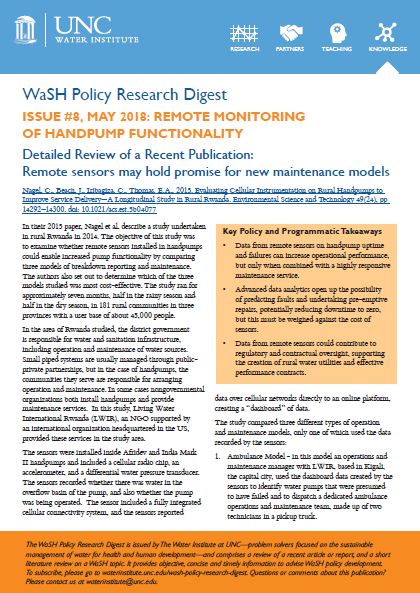
2018 ; 4 pages
Ed. UNC The Water Institute - Chapel hill
Abstract:
The eighth issue of the WaSH Policy Research Digest focuses on remote monitoring of the functionality of rural handpumps.
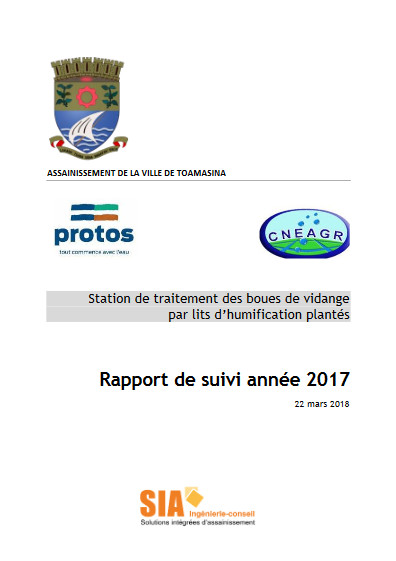
2018 ; 41 pages
Ed. CNEAGR - Antananarivo CU Toamasina - Toamasina Join For Water - Antananarivo Join For Water - Toamasina Join For Water - Gent Practica Foundation - Antananarivo
Résumé:
La ville de Tamatave s’est équipée, via le support de PROTOS et de PRACTICA, d’une station de traitement des boues de vidange (STBV) par lits d’humification plantés, mise en exploitation à partir de juillet 2016.
Suite à la mise en service mi 2016, une équipe d’exploitation du CNEAGR prend le relai. Cette équipe a pour objectif la gestion opérationnelle de la station et l’optimisation du traitement. N’ayant pas encore d’expérience dans la thématique, l’équipe d’exploitation a besoin d’un appui technique et scientifique pour la développer. Par ailleurs l’exploitation de la station nécessite toujours une mise au point concernant :
- Le réglage des rythmes et volumes de déversement pour une humification optimale des différents types de boue et selon les saisons ;
- L’intérêt d’une autre espèce macrophyte, du lombricompostage ou du séchage non-planté ;
- Le pilotage de l’exploitation à travers des indicateurs simples.
Le présent rapport présente les données techniques d’exploitation pour l’année 2017, en particulier les charges reçues et l’évolution des indicateurs suivis. Il fait suite au rapport de démarrage du deuxième semestre 2016. Il est organisé en trois parties :
- La première présente les conditions subies par les différents lits, notamment en ce qui concerne les volumes reçus, type de boues reçus et météorologie.
- Les réactions des lits à ces conditions sont présentées et analysées dans la partie suivante, en termes de développement végétal (indicateur de la santé des lits), d’épisodes de stress et de production d’humus.
- Enfin, les conclusions portent sur les leçons tirées en 2017 et proposent des axes d’exploitation pour l’année 2018.
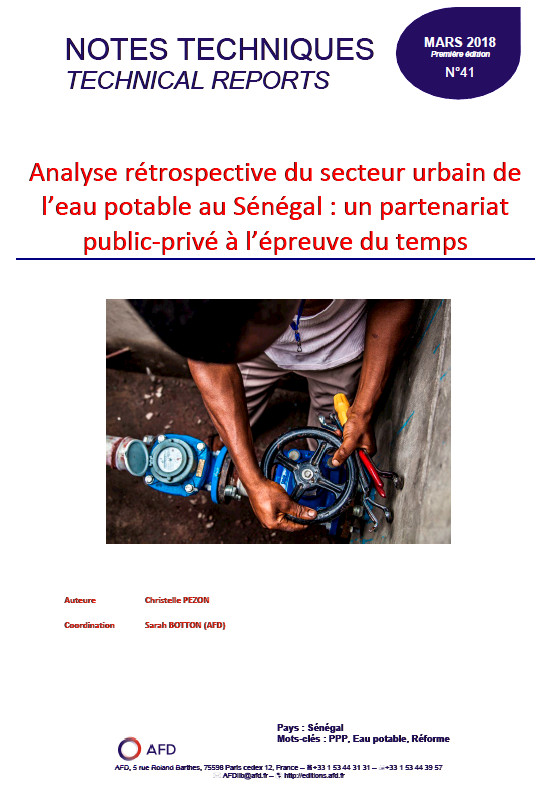
2018 ; 52 pages PdF
Ed. AFD - Paris
Résumé:
Cette étude, commanditée par la direction Innovation, Recherche et Savoirs de l’AFD, propose une analyse rétrospective du Partenariat Public-Privé (PPP) qui gouverne le sous-secteur hydraulique urbain du Sénégal depuis 1995. Depuis quelques années, des signaux inquiétants s’accumulent au point que plusieurs bailleurs ont décidé de passer en prêt souverain, faute d’une confiance suffisante dans les capacités financières du partenaire public, la société de patrimoine, à honorer ses engagements. Les motifs de satisfaction restent toutefois nombreux. Le Sénégal a atteint ses objectifs en matière d’accès à l’eau potable et ses performances en milieu urbain sont remarquables : Dakar affiche un taux d’accès supérieur à 98%, taux qui avoisine les 80% dans le périmètre qui fait l’objet du PPP. Mieux, le Sénégal est l’un des trois pays du continent africain où le taux de raccordement de la population, par branchement domiciliaire, s’est accru de plus de 25%, derrière le Botswana (+52%) et devant le Maroc (+25%) avec + 33%, entre 1990 et 2015. En terme méthodologique, cette étude s’appuie sur les documents contractuels (contrats, annexes et avenants depuis 1996), les rapports d’activité des 10 dernières années des deux sociétés (société de patrimoine et société d’exploitation) et la littérature grise et académique. Cette première étape a permis d’identifier et de caractériser les principaux points de rupture du PPP originel. Elle s’est poursuivie avec des entretiens des acteurs clés du sous-secteur, en février 2017, pour préciser la nature de ces points de rupture, et en expliquer les causes et les conséquences.
Abstract:
This study, commissioned by the AFD Innovation, Research and Knowledge department, provides a retrospective analysis of the Public-Private Partnership (PPP) that has been managing the urban water supply sub-sector in Senegal since 1995. For a number of years now, this PPP arrangement has been showing increasingly worrying signs of decline, to the point that several donors have decided to move to sovereign loans as they no longer have sufficient confidence in the ability of the public partner, the asset-holding company, to uphold its commitments. However, grounds for satisfaction remain. Senegal has achieved its access to water targets and the progress made in urban areas has been remarkable: Dakar has water supply coverage of over 98%, a figure that is around 80% in the area under PPP management. What is more, Senegal is one of only three countries in Africa where the household connection rate has grown by over 25%, behind Botswana (+52%) and ahead of Morocco (+25%), rising by + 33% between 1990 and 2015. In methodological terms, this study is based on a review of contractual documents (contracts, appendices and amendments produced since 1996), the two companies’ last ten annual reports (the asset-holding company and operator), as well as gray and academic literature. The aim of this initial stage has been to identify and describe the main turning points of the original PPP. It has been followed up by interviews with key sector stakeholders in February 2017 to determine the exact nature of these turning points and explain their causes and impacts.
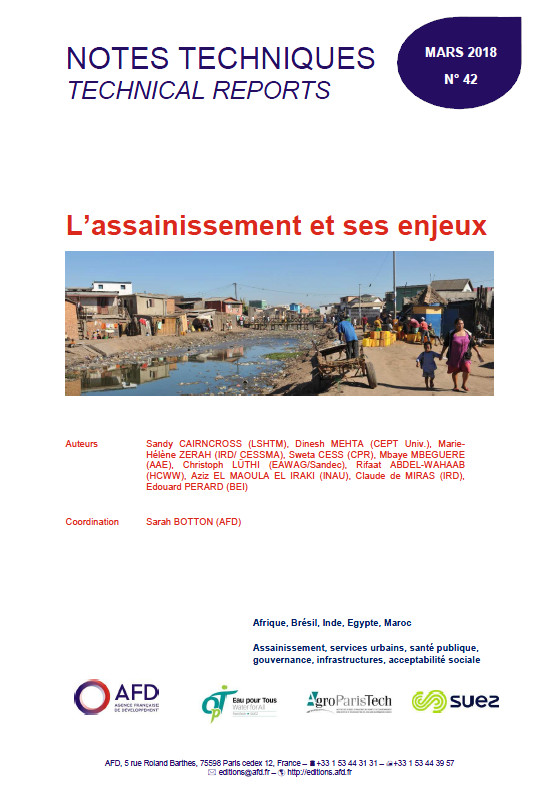
2018 ; 61 pages
Ed. AFD - Paris
Résumé:
Parmi les services publics en réseaux, l'assainissement présente des modalités d'organisation et de gestion particulières qui tendent à en faire le parent pauvre des politiques publiques de développement des infrastructures. Les retards cumulés, et constatés, dans l'offre de services aux populations des pays émergents et en développement le confirment. Néanmoins, les raisons de ce constat sont multiples et le sujet est vaste.
Pour discuter de cette question, la Chaire ParisTech-Suez "Eau pour Tous" a organisé, avec le soutien de l'Agence Française de Développement et d'AgroParisTech, son 3ème Rendez-vous scientifique du 18 Novembre 2016 sur : "L'assainissement et ses enjeux".
La présente publication rend compte des interventions, des discussions et des échanges qui se sont tenus lors de ce Rendez-vous. Elle fait le choix de focaliser sur les enjeux et de privilégier les facettes organisationnelles, économiques et sociales.
Le bilan s'organise autour de trois questions structurantes et met en discussion les conditions de réussite concrètes, parfois contradictoires, des expériences et des innovations.
• Comment expliquer que les bénéfices réels de l'assainissement en termes de santé publique et de sécurité, notamment pour les femmes, ne se traduisent pas par une forte demande des usagers et par des politiques publiques plus ambitieuses?
• Quelles coordinations sont effectivement à mettre en place entre assainissement autonome et assainissement en réseau, et à quelle échelle ?
• Comment l'irruption des préoccupations environnementales et la participation accrue des usagers fait-elle évoluer les politiques publiques d'assainissement et leurs modes de financement ?
Même si leur intensité relative dépend de chaque contexte, les forces motrices des évolutions en cours trouvent souvent leur origine dans les évolutions démographiques, le changement climatique et la croissance urbaine dans les grandes métropoles et leurs quartiers périphériques.
Enfin, la nécessité de recourir à des approches globales et à la pluridisciplinarité apparaît de plus en plus partagée.
Abstract:
Among the essential public utilities, sanitation and wastewater services present forms of organization and management that have contributed to make it low on the agenda of policy makers when it comes to the development of infrastructures. Backlogs in the provision of services to populations in emerging and developing countries confirm this fact. At the same time, the reasons for this are multiple and the issue is broad.
The report centers on three key questions and discusses concrete, sometimes competing, conditions for successful experiences and innovations.
• How to explain that real benefits of sanitation in terms of public health and safety, especially for women, do not translate into high demand from users and more ambitious public policies?
• What coordination efforts must effectively be established between autonomous sanitation and networked sanitation, and on what scale?
• How have the emergence of environmental concerns and the increased participation of users caused public sanitation policies and their financing to change?
Even if their relative intensity depends on the context, driving forces often originate from demographic developments, climate change and urban growth in large metropolitan areas and surrounding suburbs. Lastly, there appears to be a growing consensus on the need to resort to holistic approaches and multidisciplinarity.
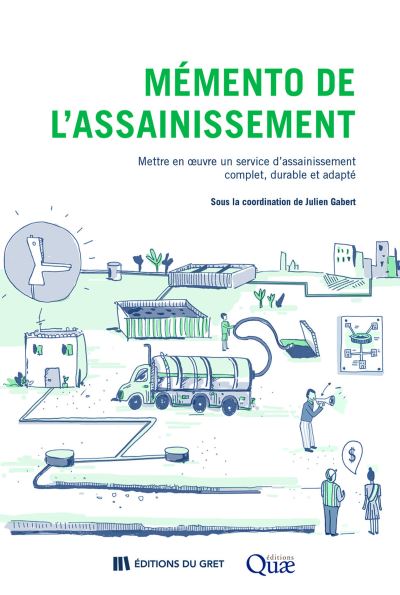
2018 ; 844 pages
Ed. GRET - Nogent sur Marne Quae - Versailles
Résumé:
Le Mémento de l’assainissement est un guide méthodologique et pratique pour la mise en œuvre opérationnelle de services d’assainissement liquide dans les pays du Sud.
Il couvre l’ensemble de la filière, de la collecte des eaux usées et boues de vidange jusqu’à leur traitement, et ses recommandations s’appliquent au contexte rural, urbain et semi-urbain.
Destiné aux acteurs concernés par l’élaboration et la gestion d’un service d’assainissement complet, durable et adapté, cet ouvrage propose des pistes de réflexion, des méthodologies ainsi que des outils pour répondre à trois grandes questions.
• Comment décider et planifier un service d’assainissement dans une localité ?
• Quelles sont les étapes et la méthodologie de mise en place de ces services ?
• Comment gérer et suivre durablement ces services ?
L’objectif du Mémento est d’apporter tous les éléments d’aide à la décision aux praticiens en charge de programmes d’assainissement liquide. Il détaille, à chacune des étapes décisionnelles et pour chaque maillon de la filière, les clés de compréhension et les critères de choix entre différentes solutions.
Cet ouvrage se caractérise par son approche globale de la mise en place d’un service : les étapes de conception, de mise en oeuvre et de suivi du fonctionnement du service sont traitées au travers de leurs dimensions techniques, économiques, institutionnelles (acteurs) et de communication.
Le Mémento se distingue également par son traitement pratique, tirant ses enseignements des diverses expériences menées par le Gret sur plusieurs continents. En se fondant sur un cheminement pédagogique et progressif, il propose des chapitres théoriques émaillés de nombreuses études de cas et d’illustrations, une série de fiches techniques ainsi qu’une boîte à outils (disponible sur la clé USB fournie avec cet ouvrage) facilitant la mise en oeuvre opérationnelle.
Un site Internet dédié au Mémento de l’assainissement est disponible à l’adresse suivante : http://memento-assainissement.gret.org
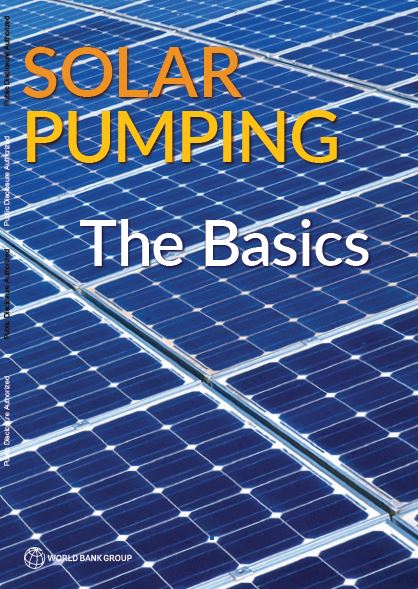
2018 ; 32 pages
Ed. World Bank - Washington
Abstract:
Solar photovoltaic water pumping (SWP) uses energy from solar photovoltaic (PV) panels to power an electric water pump. The entire process, from sunlight to stored energy, is elegant and simple. Over last seven years, the technology and price of solar pumping have evolved dramatically and hence the opportunities it presents. Solar pumping is most competitive in regions with high solar insolation, which include most of Africa, South America, South Asia, and Southeast Asia. This book focuses on the basics of Solar pumping.
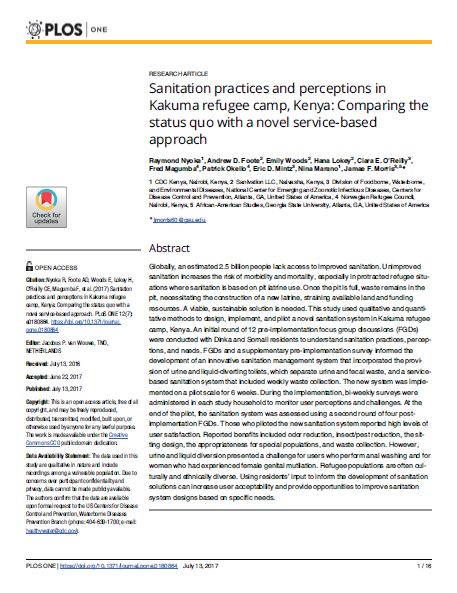
2017 ; 16 pages
Ed. PLOS - San Francisco
Abstract:
Globally, an estimated 2.5 billion people lack access to improved sanitation. Unimproved sanitation increases the risk of morbidity and mortality, especially in protracted refugee situations where sanitation is based on pit latrine use. Once the pit is full, waste remains in the pit, necessitating the construction of a new latrine, straining available land and funding resources. A viable, sustainable solution is needed. This study used qualitative and quantitative methods to design, implement, and pilot a novel sanitation system in Kakuma refugee camp, Kenya. An initial round of 12 pre-implementation focus group discussions (FGDs) were conducted with Dinka and Somali residents to understand sanitation practices, perceptions, and needs. FGDs and a supplementary pre-implementation survey informed the development of an innovative sanitation management system that incorporated the provision of urine and liquid-diverting toilets, which separate urine and fecal waste, and a service-based sanitation system that included weekly waste collection. The new system was implemented on a pilot scale for 6 weeks. During the implementation, bi-weekly surveys were administered in each study household to monitor user perceptions and challenges. At the end of the pilot, the sanitation system was assessed using a second round of four post-implementation FGDs. Those who piloted the new sanitation system reported high levels of user satisfaction. Reported benefits included odor reduction, insect/pest reduction, the sitting design, the appropriateness for special populations, and waste collection. However, urine and liquid diversion presented a challenge for users who perform anal washing and for women who had experienced female genital mutilation. Refugee populations are often culturally and ethnically diverse. Using residents’ input to inform the development of sanitation solutions can increase user acceptability and provide opportunities to improve sanitation system designs based on specific needs.
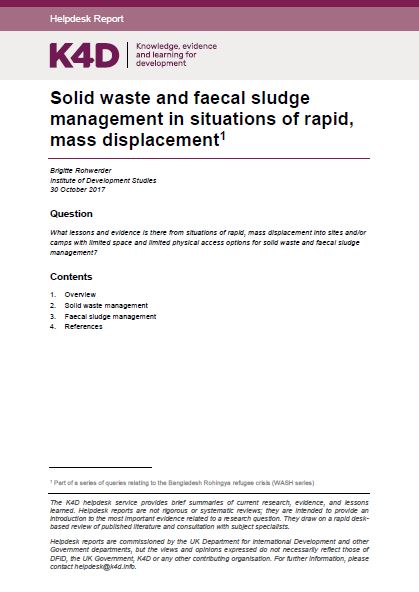
2017 ; 14 pages
Ed. IDS - Brighton
Abstract:
Solid waste and faecal sludge management in situations of rapid mass displacement are important to public health and providing for a better environment. Despite this, both have been neglected in WASH programmes, which tend to have a focus on water. However increasing efforts are being made to find solutions to challenges in solid waste and faecal sludge management in difficult circumstances in humanitarian emergencies.
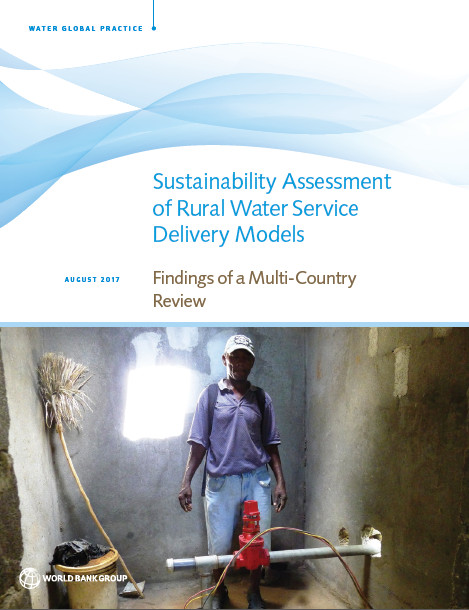
2017 ; 181 pages
Ed. World Bank - Washington
Abstract:
With 2.1 billion people – mostly in rural areas – lacking safely managed drinking water and reported low rural water supply functionality rates, the Sustainable Development Goals pose a triple challenge: to reach unserved mostly rural population groups, to raise service levels, and to sustain existing and future services. This assessment uses a multi-country case study approach to identify good practices and challenges toward building sector capacity and strengthening sustainable service delivery models for rural areas. Recognizing the limitations of the Demand Responsive Approach, the emergence of various management models, the identified need for ongoing support to rural service providers, and the critical role of enabling institutions and policies beyond the community-level, the added value of this assessment lies in: i)the development of a comprehensive analytical framework that can be used to analyze and operationalize a more sustainable service delivery approach for rural water supply; ii) the rich set of cases and good practices from the 16 countries informing the global body of "knowledge in implementation," and iii) the formulation of recommendations and policy directions to improve the sustainability of services depending on sector development stage. Policy recommendations are centered around five areas: institutional capacity, financing, asset management, water resources management, and monitoring and regulatory oversight.
Based on a set of 16 country cases, the assessment proposes a number of policy recommendations and potential interventions, depending on the context of rural service provision - remote versus urbanizing - as well as sector development stage.
- countries: Bangladesh, Benin, Brazil
(state of Ceará), China (Zhejiang and Shaanxi provinces), Ethiopia, Ghana, Haiti, India
(Punjab and Uttarakhand states), Indonesia, the Kyrgyz Republic, Morocco, Nepal,
Nicaragua, the Philippines, Tanzania, and Vietnam.
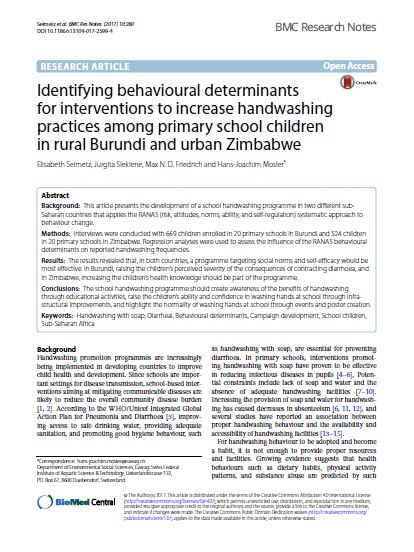
2017 ; 9 pages
Ed. BMC - London
Abstract:
Background:
This article presents the development of a school handwashing programme in two different sub‑Saharan countries that applies the RANAS (risk, attitudes, norms, ability, and self‑regulation) systematic approach to behaviour change.
Methods:
Interviews were conducted with 669 children enrolled in 20 primary schools in Burundi and 524 children in 20 primary schools in Zimbabwe. Regression analyses were used to assess the influence of the RANAS behavioural determinants on reported handwashing frequencies.
Results:
The results revealed that, in both countries, a programme targeting social norms and self‑efficacy would be most effective. In Burundi, raising the children’s perceived severity of the consequences of contracting diarrhoea, and in Zimbabwe, increasing the children’s health knowledge should be part of the programme.
Conclusions:
The school handwashing programme should create awareness of the benefits of handwashing through educational activities, raise the children’s ability and confidence in washing hands at school through infrastructural improvements, and highlight the normality of washing hands at school through events and poster creation.
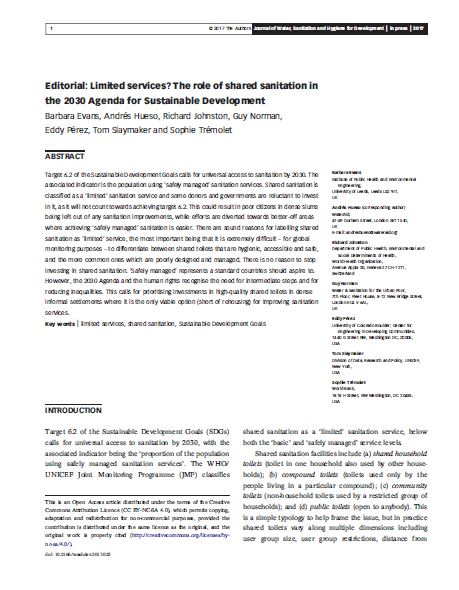
2017 ; 3 pages
Ed. IWA - London
Abstract:
Target 6.2 of the Sustainable Development Goals calls for universal access to sanitation by 2030. The associated indicator is the population using ‘safely managed’ sanitation services. Shared sanitation is classified as a ‘limited’ sanitation service and some donors and governments are reluctant to invest in it, as it will not count towards achieving target 6.2. This could result in poor citizens in dense slums being left out of any sanitation improvements, while efforts are diverted towards better-off areas where achieving ‘safely managed’ sanitation is easier. There are sound reasons for labelling shared sanitation as ‘limited’ service, the most important being that it is extremely difficult – for global monitoring purposes – to differentiate between shared toilets that are hygienic, accessible and safe, and the more common ones which are poorly designed and managed. There is no reason to stop investing in shared sanitation. ‘Safely managed’ represents a standard countries should aspire to. However, the 2030 Agenda and the human rights recognise the need for intermediate steps and for reducing inequalities. This calls for prioritising investments in high-quality shared toilets in dense informal settlements where it is the only viable option (short of rehousing) for improving sanitation services.
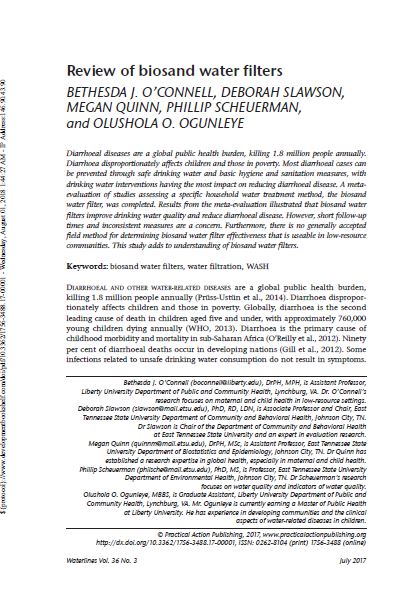
2017 ; 10 pages
Ed. Practical Action - Rugby
Abstract:
Diarrhoeal diseases are a global public health burden, killing 1.8 million people annually. Diarrhoea disproportionately affects children and those in poverty. Most diarrhoeal cases can be prevented through safe drinking water and basic hygiene and sanitation measures, with drinking water interventions having the most impact on reducing diarrhoeal disease. A meta-evaluation of studies assessing a specific household water treatment method, the biosand water filter, was completed. Results from the meta-evaluation illustrated that biosand water filters improve drinking water quality and reduce diarrhoeal disease. However, short follow-up times and inconsistent measures are a concern. Furthermore, there is no generally accepted field method for determining biosand water filter effectiveness that is useable in low-resource communities. This study adds to understanding of biosand water filters.
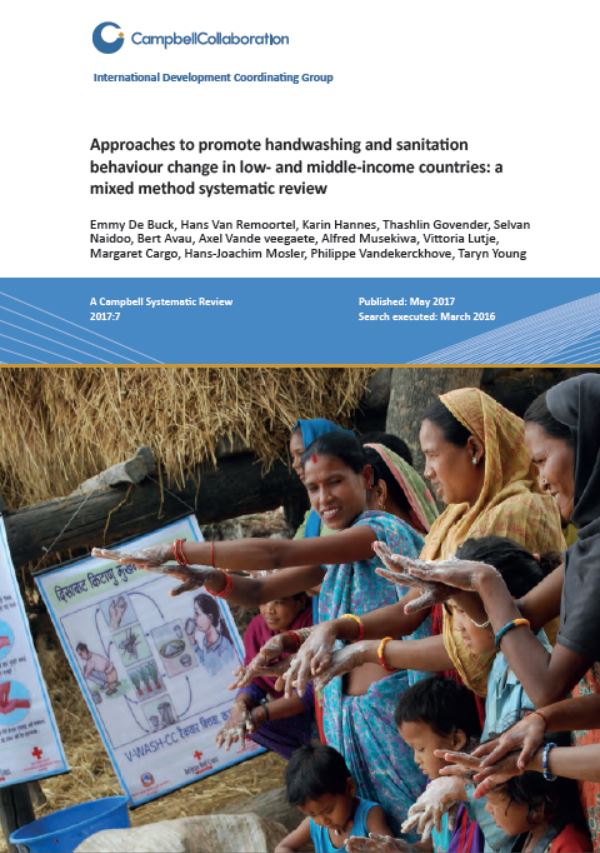
2017 ; 452 pages
Ed. Campbell Collaboration - Oslo
Abstract:
About this systematic review
This Campbell systematic review examines the effectiveness of different approaches for promoting handwashing and sanitation behaviour change, and factors affecting implementation, in low and middle-income countries. The review summarises evidence from 42 impact evaluations, and from 28 qualitative studies.
What are the main results?
Community-based approaches which include a sanitation component can increase handwashing with soap at key times; use of latrines and safe disposal of faeces; and reduce the frequency of open defecation. Social marketing seems less effective. The approach mainly shows an effect on sanitation outcomes when interventions combine handwashing and sanitation components.
Sanitation and hygiene messaging with a focus on handwashing with soap has an effect after the intervention has ended, but there is little impact on sanitation outcomes. However, these effects are not sustainable in the long term. Using elements of psychosocial theory in a small-scale handwashing promotion intervention, or adding theory-based elements such as infrastructure promotion or public commitment to an existing promotional approach, seem promising for handwashing with soap.
None of the approaches described have consistent effects on behavioural factors such as knowledge, skills and attitude. There are no consistent effects on health.
Background
Water and sanitation are at the very core of sustainable development, critical to the survival of people and the planet. The Sustainable Development Goal 6 (i.e. "ensure availability and sustainable management of water and sanitation for all") addresses the issues relating to drinking water, sanitation and hygiene. It is unclear which Water, Sanitation and Hygiene (WASH) promotional approach is the most effective for sanitation and hygiene behaviour change, and other outcomes leading to behaviour change (e.g. learning outcomes) or longer term outcomes that follow from behaviour change (e.g. mortality, morbidity).
Objectives
The overall goal of this systematic review is to show which promotional approaches are effective in changing handwashing and sanitation behaviour, and which implementation factors affect the success or failure of such interventions. This goal is achieved by answering two different review questions.
Question 1: What is the effectiveness of different approaches for promoting handwashing and sanitation behaviour change, in communities in low- and middle-income countries?
Question 2: What factors influence the implementation of approaches to promote handwashing and sanitation behaviour change, in communities in low- and middle-income countries?
Search methods
A comprehensive search was conducted to identify both published and unpublished studies. Using a sensitive search strategy, we searched the following databases from 1980 to March 2016: Medline (PubMed), Cochrane CENTRAL Issue 2, Applied Social Sciences index and abstracts (ASSIA, ProQuest), Global Health (CABI), EMBASE (OVID), PsycInfo (EBSCOHost), ERIC (EBSCOHost), Global Index Medicus, 3ie Impact Evaluation Database, International bibliography of the Social Sciences (IBSS, ProQuest), Sociological abstracts (ProQuest) and Social Sciences citation index (SSCI, Web of Science). To find unpublished material and relevant programme documents, we contacted various research groups and organizations and/or checked the relevant websites.
Selection criteria
Participants included both children and adults from low- and middle-income countries (LMICs), as defined by the World Bank, at the time the intervention was implemented. Studies performed at an individual, household, school or community level were included, whereas studies conducted in institutional settings (e.g. hospitals) were excluded. The following promotional approaches or elements to promote handwashing, latrine use, safe faeces disposal, and to discourage open defecation (primary outcomes), were included: community-based approaches, social marketing approaches, sanitation and hygiene messaging and elements of psychosocial theory. Secondary outcomes of interest were behavioural factors (knowledge, skills, attitude, norms, self-regulation) and health outcomes (morbidity, mortality).
For Question 1 (effectiveness of promotional approaches), we included impact evaluations using an experimental, quasi-experimental design and observational analytical studies. To answer Question 2 (implementation aspects), all qualitative study designs addressing factors influencing implementation of the promotional approaches were considered for inclusion. This included, for example, grounded theory, case studies, phenomenological studies, ethnographic research, action research and thematic approaches to qualitative data analysis.
Data collection and analysis
Study selection and data extraction (including risk of bias assessment) were performed independently by two reviewers, using EPPI-Reviewer software. Study authors of all included papers were contacted by email (in July 2016) to ask for any relevant information, related to the population, intervention or outcomes, that was missing or not reported in the paper. Any disagreements between the two data extractors were resolved through discussion, or by consulting another review co-author. The GRADE (Grading of Recommendations Assessment, Development and Evaluation) approach was used to assess the overall quality/certainty of evidence from quantitative studies included in this review. The qualitative studies were assessed using the CASP (Critical Appraisal Skills Program) checklist. Evidence relating to Question 1 (effectiveness of promotional approaches) was synthesized in a quantitative way (meta-analysis), where possible.
Results
Forty-two quantitative studies and 28 qualitative studies met the inclusion criteria. The quantitative studies were conducted in LMICs worldwide, with the majority of the studies in South Asia and Sub-Saharan Africa. Most quantitative studies (69%) were performed in a rural setting and only 14% of the studies took place in an urban setting (with an additional 10% in an “informal-rural setting”). The effect of a promotional approach versus not using a promotional approach on sanitation and handwashing behaviour change, behavioural factors (knowledge, skills, attitude, norms and self-regulation) and health-related outcomes (morbidity and mortality), was studied in 34 different studies. In addition, seven studies compared specific promotional approaches versus other promotional approaches, and one study compared two different communication strategies. All studies showed substantial variability in programme content, study types, outcome types, methods of outcome measurement and timing of measurement.
Risk of bias assessments of included studies were influenced by unclear reporting or lack of reporting of key methodological aspects of the study design and process. Five percent of the experimental studies (n=2) had a high risk of selection bias, 40% had a high risk of detection bias (n=17), 28% had a high risk of attrition bias (n=12) and 48% had a high risk of reporting bias (n=20). Most quasi-experimental and observational studies had bias in the selection of participants, some were at high risk of confounding, methods of outcome assessment were not comparable across intervention groups, and outcome assessors were aware of the interventions that the groups received. For the body of evidence, in most assessments, the certainty of evidence was considered as ‘low’ and in some cases ‘moderate’ or ‘very low'. For the qualitative studies, an overall CASP score was given to the studies, and only 21% of the studies had a score less than 8/10. In studies with a lower score the relationship between researcher and participants was not adequately considered or ethical issues were not explicitly reported.
We categorised the studies into four categories of promotional approaches or elements:
(1) community-based approaches, a promotional approach where there is typically community involvement and engagement, and shared decision-making is part of the approach. All but one study in this category implemented a sanitation intervention, in some cases combined with a handwashing with soap and/or water supply/water quality component.
(2) social marketing approaches, a promotional approach combining enterprise approaches with demand stimulation, and assuming that people both want and are able to change their behaviour. All but two studies in this category implemented a handwashing with soap intervention, in some cases combined with a sanitation and/or water supply/water quality component.
(3) sanitation and hygiene messaging, is a predominantly directive educational approach, consisting mainly of one-way communication, designed to help individuals and communities improve their health, by increasing their knowledge and/or skills. All but one study in this category implemented a handwashing with soap intervention, in some cases combined with a sanitation and/or water supply/water quality component.
(4) elements of psychosocial theory, which are derived from a formal psychosocial theory and form the basis of the intervention. All but one study in this category implemented a handwashing-only intervention, and one study implemented a combined handwashing and sanitation intervention.
The most consistent results were obtained within the category of community-based approaches, where at least a sanitation component was part of the programme. Working in a community-based way may be effective in terms of handwashing with soap, and sanitation outcomes (latrine use, safe faeces disposal, and open defecation). Limited positive results on the knowledge of key handwashing times were found. Influencing factors that could play a specific role in the implementation of community-based interventions are: a facilitator (e.g. health promoter, community leader) that is part of and representative of the community, the attitude of the implementer/facilitator, providing enough information, and creating a culture of cooperation. In addition, the gender of the facilitator seems to play an important role, since women prefer to discuss private issues with somebody of the same sex.
The use of social marketing approaches seems to be less uniformly applicable, and mainly show an effect on sanitation outcomes when interventions have a combined handwashing and sanitation component. A specific barrier that could play a role in the implementation of social marketing interventions was the use of sanitation loans (slow and expensive process, not reaching the poor and people with lack of financial knowledge). Additional income generation would be an important facilitator for this type of approach.
Sanitation and hygiene messaging, with a focus on handwashing with soap, seem to have an effect on handwashing programmes immediately after the intervention has ended. However, these effects are not sustainable in the long term. This type of promotional approach may make little or no difference to sanitation outcomes. With this approach it seems key that messages are delivered using active teaching methods and that messaging is innovative and culturally sensitive. In case of school level interventions with children, the duration of the intervention and involving the children’s parents seem to be positive influencing factors.
Using elements of psychosocial theory in a small-scale handwashing promotion intervention, or adding theory-based elements such as infrastructure promotion or public commitment to an existing promotional approach, seems promising for handwashing with soap.
Finally, the methods used for communicating the content of a certain promotional approach, also play a role, and use of interpersonal communication was shown to be effective in certain circumstances.
We only found a limited number of studies that incorporated a range of incentives (from soap bars to food or subsidies) into the promotional approach. One study reported promising results when using subsidies as part of the community-based approach, but more research on the use of subsidies and incentives would be valuable.
None of the promotional approaches described in the review showed consistent effects on behavioural factors such as knowledge, skills and attitude. Also no consistent effects on health were demonstrated.
Facilitators which were relevant across different promotional approaches were: length of the approach, visit frequency, using short communication messages, availability of training materials, funding/resources and partnerships, kindness and respect of the implementer, accessibility of the implementer, and the implementer’s authority/status; as well as, on the side of the recipient, awareness about costs and benefits, social capital, access to infrastructure and availability of space, and others showing the behaviour.
Authors’ conclusions
Implications for policy and practice
Based on our findings, promotional approaches aimed at handwashing and sanitation behaviour change can be effective in terms of handwashing with soap, latrine use, safe faeces disposal and open defecation. Findings from experimental, quasi-experimental design and observational analytical studies show that a combination of different promotional elements is probably the most effective strategy. The recognition of different barriers and facilitators that influence the implementation of these promotional approaches may have a triggering effect on its effectiveness.
Implications for research
An important implication of our work is that there is an urgent need to use a more uniform method of outcome measurement (type of outcomes, way of assessment, timing of assessment). This will facilitate making conclusions on the effects of promotional approaches in the future. In addition, it is important to further assess barriers and facilitators, identified in this review, alongside quantitative analyses of promotional approaches.
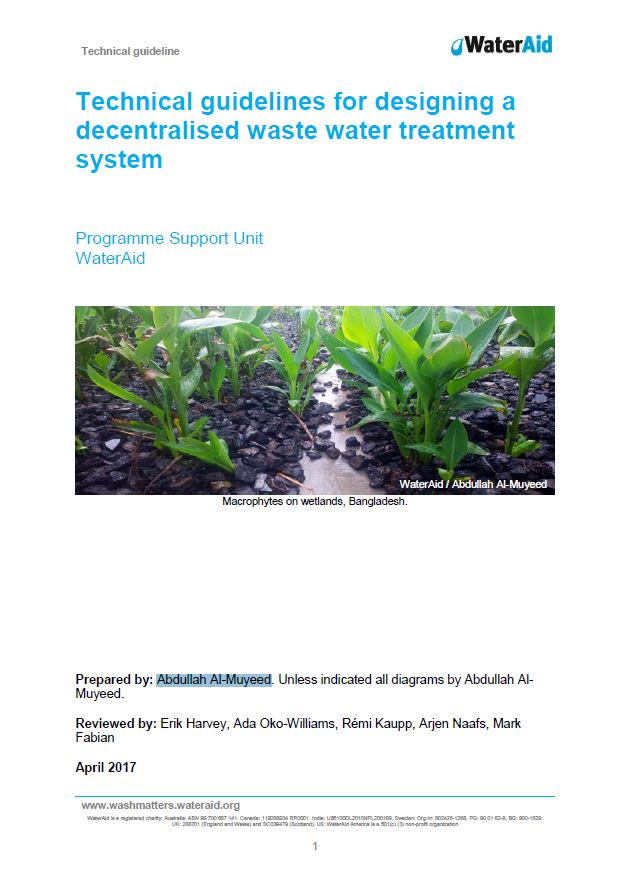
2017 ; 27 pages
Ed. WaterAid - London
Abstract:
This guidance document helps with the implementation of a decentralised waste water treatment system or DWTS, based on the experience of several WaterAid country programmes and especially WaterAid Bangladesh.
A DWTS can be used to treat the waste water coming from houses and institutional settings, and represents an alternative to centralised treatment involving sewers and large treatment plants, and therefore large capital costs and running costs. A DWTS can be relatively compact, cheaper to install, and requires little maintenance and no energy input.
A DWTS typically consists of several elements: a septic tank, an anaerobic baffled reactor, an anaerobic filter, and a series of constructed wetlands. The exact dimensions and types of installations depend on many parameters, which are covered in this guideline.
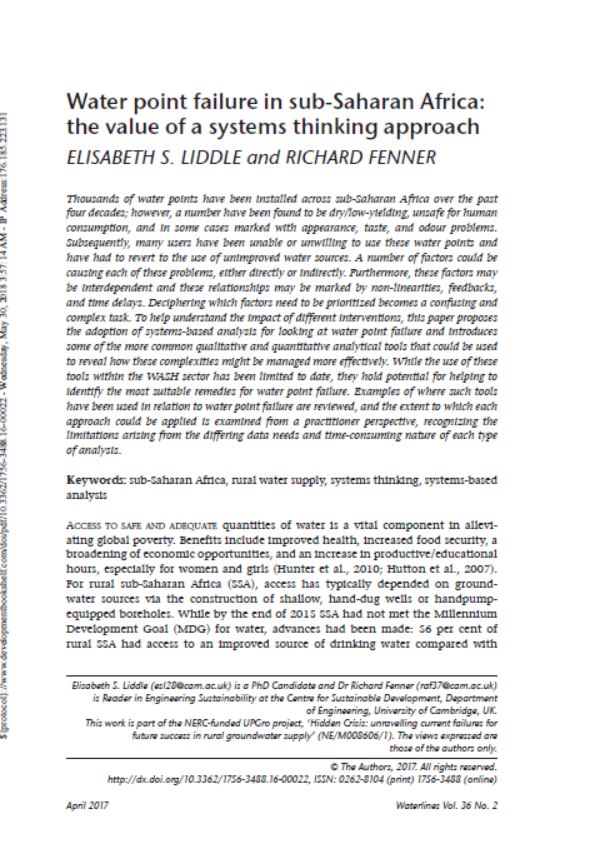
2017 ; 27 pages
Ed. Practical Action - Rugby
Abstract:
Thousands of water points have been installed across sub-Saharan Africa over the past four decades; however, a number have been found to be dry/low-yielding, unsafe for human consumption, and in some cases marked with appearance, taste, and odour problems. Subsequently, many users have been unable or unwilling to use these water points and have had to revert to the use of unimproved water sources. A number of factors could be causing each of these problems, either directly or indirectly. Furthermore, these factors may be interdependent and these relationships may be marked by non-linearities, feedbacks, and time delays. Deciphering which factors need to be prioritized becomes a confusing and complex task. To help understand the impact of different interventions, this paper proposes the adoption of systems-based analysis for looking at water point failure and introduces some of the more common qualitative and quantitative analytical tools that could be used to reveal how these complexities might be managed more effectively. While the use of these tools within the WASH sector has been limited to date, they hold potential for helping to identify the most suitable remedies for water point failure. Examples of where such tools have been used in relation to water point failure are reviewed, and the extent to which each approach could be applied is examined from a practitioner perspective, recognizing the limitations arising from the differing data needs and time-consuming nature of each type of analysis.
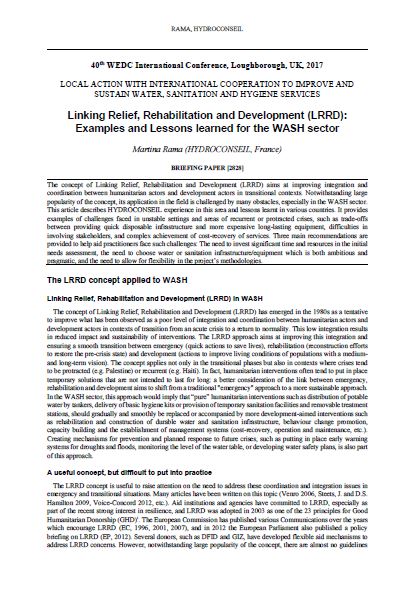
2017 ; 6 pages PdF
Ed. Hydroconseil - Avignon WEDC - Loughborough
Abstract:
The concept of Linking Relief, Rehabilitation and Development (LRRD) aims at improving integration and coordination between humanitarian actors and development actors in transitional contexts. Notwithstanding large popularity of the concept, its application in the field is challenged by many obstacles, especially in the WASH sector.
This article describes HYDROCONSEIL experience in this area and lessons learnt in various countries. It provides examples of challenges faced in unstable settings and areas of recurrent or protracted crises, such as trade-offs between providing quick disposable infrastructure and more expensive long-lasting equipment, difficulties in involving stakeholders, and complex achievement of cost-recovery of services. Three main recommendations are provided to help aid practitioners face such challenges: The need to invest significant time and resources in the initial needs assessment, the need to choose water or sanitation infrastructure/equipment which is both ambitious and pragmatic, and the need to allow for flexibility in the project’s methodologies.
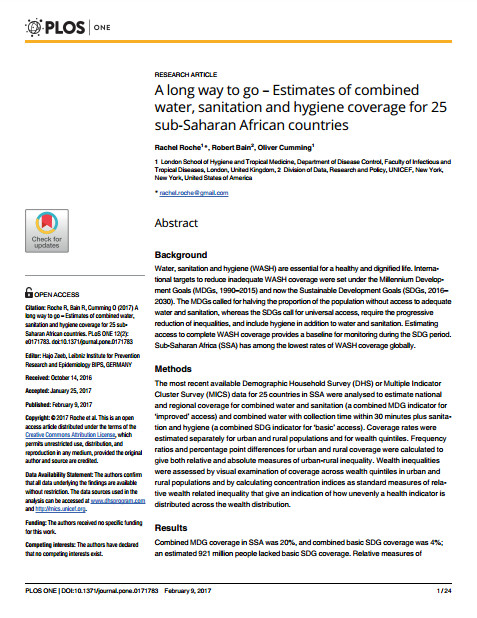
2017 ; 24 pages
Ed. PLOS - San Francisco
Abstract:
Water, sanitation and hygiene (WASH) are essential for a healthy and dignified life. International targets to reduce inadequate WASH coverage were set under the Millennium Development Goals (MDGs, 1990–2015) and now the Sustainable Development Goals (SDGs, 2016– 2030). The MDGs called for halving the proportion of the population without access to adequate water and sanitation, whereas the SDGs call for universal access, require the progressive reduction of inequalities, and include hygiene in addition to water and sanitation. Estimating access to complete WASH coverage provides a baseline for monitoring during the SDG period. Sub-Saharan Africa (SSA) has among the lowest rates of WASH coverage globally.
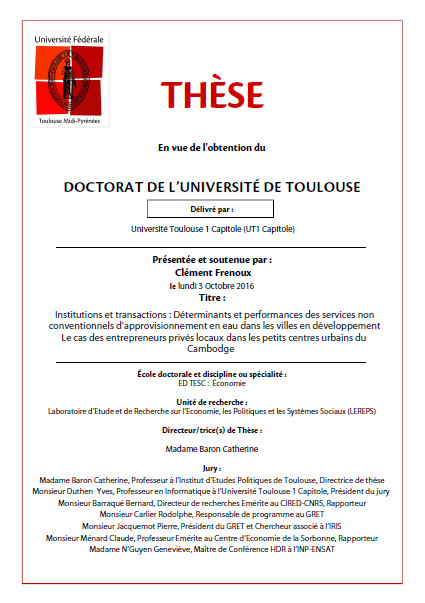
2016 ; 454 pages PdF
Ed. Université de Toulouse 1 - Toulouse
Résumé:
Petits opérateurs privés, vendeurs d’eau informels, fournisseurs non-étatiques… de nouveaux acteurs participent à la gouvernance des services d’approvisionnement en eau potable des villes en développement. Longtemps ignorés, ils connaissent aujourd’hui un intérêt croissant de la part de la communauté internationale car ils questionnent les modalités de gouvernance des services en réseaux au Sud. Hétérogènes et composites, d’origine locale, adaptés aux demandes des usagers, les services non conventionnels disposeraient d’une grande flexibilité convenant à l’environnement particulier des villes en développement. Ils seraient également en mesure d’apporter de nouveaux financements et d’assurer une pérennité du service à plus ou moins long terme. Or, peu de travaux théoriques en sciences économiques ont été entrepris sur cet objet de recherche. Nous le confirmerons à l’aide d’une analyse bibliométrique inédite.
Cette thèse a donc pour objectif de combler ce manque, dans ses dimensions théoriques et empiriques. Adoptant une posture critique, elle s’emploie à discuter les postulats et les hypothèses d’efficience non-vérifiées de ce mode de coordination des acteurs. Par la suite, elle mobilise les concepts issus de la Nouvelle Economie Institutionnelle, proposant une grille de lecture originale des déterminants et de l’efficience des services non conventionnels. Grâce à une enquête de terrain approfondie conduite au Cambodge, nous critiquons le « caractère » concurrentiel qui fonde à priori ce(s) mode(s) de gouvernance. Nous montrons plutôt l’impact des coûts de transaction sur les arrangements organisationnels liés aux conditions d’accès à la ressource en eau. Au-delà de la rhétorique sur l’efficience des agents privés, nous soulignons également l’importance de considérer les arrangements organisationnels non-sectoriels. Nous apportons enfin des éclairages sur le rôle joué par les normes informelles dans la réduction des incertitudes de l’environnement institutionnel.
Nous concluons toutefois sur les difficultés potentielles d’institutionnalisation de ce(s) mode(s) de gouvernance car verrouillé dans un sentier de dépendance institutionnel.
Abstract:
Small-scale private operators, informal water vendors, non-state providers… new stakeholders are participating in water supply governance in developing cities. Previously ignored, they are today drawing growing attention from the international community as they question the governance modalities of network industries in the Global South. Heterogeneous and composite, of local origin, adapted to the demands of end-users, alternative services would be highly flexible, thus adapted to the particular environment of developing cities. They also would be able to provide new funds and to ensure sustainability of water supply services in long or shorter term. However, there is little theoretical research in economics undertaken on this topic. We are confirming this through an unpublished bibliometric analysis. This PhD aims consequently to provide theoretical and empirical elements to fill this gap. Adopting a critical stance, it intends to highlight the postulates and unconfirmed efficiency assumptions of this particular governance structure. Thereafter, it mobilizes New Institutional Economics concepts, offering an original analytical framework on the determinants and efficiency of alternatives services. Through an extensive field survey conducted in Cambodia, we criticize the competitive character of this type of governance which is a priori supposed to ground it. We show the impact of transaction costs on the organizational arrangements related to the conditions of water resource access. Beyond the rhetoric of private sector efficiency, we also stress the importance to take into account non-sectoral organizational arrangements. We finally underline the key role of informal norms in reducing the uncertainties of the institutional environment. We nevertheless conclude on the potential difficulties to institutionalize this(hose) governance(s) structure(s) as they are locked in an institutional path-dependence.